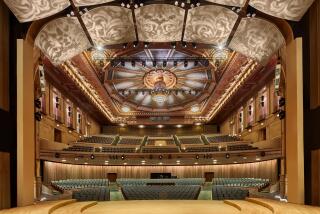Cultural Exchange: Tumultuous times at the Bolshoi Theatre
Reporting from Moscow — — The general director of the Bolshoi Theatre has confirmed that what’s seemed like a never-ending reconstruction of the Bolshoi’s historic building is finally coming to an end; he promised that a gala concert in October will cap a tough period in the life of this Russian symbol you can see on the crumpled face of a 100 ruble bill.
Anatoly Iksanov’s announcement last month, however, came like a drink designed to take away the bitter aftertaste of the theater’s most recent scandal, in which several dozen pictures of explicit homosexual sex were displayed on a short-lived website closely resembling the Bolshoi’s official one.
The impostor site contained the biography of the ballet company’s longtime manager and popular character dancer, Gennadi Yanin, who appeared in the pictures. The photographs and links to the website were sent to hundreds of people associated with ballet across the world. Before this, Yanin had reportedly been viewed as the likeliest person to lead the ballet company, perhaps as acting chief. The Bolshoi’s previous artistic ballet chief, Yuri Burlaka, quit last month after his contract was not renewed.
Yanin has quit his post as manager but remains in the company as a dancer. “My spirits are not low, and I don’t need anybody’s sympathy,” Yanin said by phone. “I’d rather people would come and enjoy the Bolshoi’s productions.”
Iksanov said the scandal was most likely the result of intrigues within the theater. “There are some people in the theater who would like to take the job of artistic director, and they must have played a role in this mean intrigue,” he said.
The troubles exposed the uneasy atmosphere inside the theater, as if its reconstruction, which has taken away the main stage for a protracted period, a financial scandal associated with it, and various managerial dust-ups have not been tumultuous enough. In 2009, the Russian Audit Chamber found the costs of the theater’s reconstruction — now estimated at more than $700 million — grossly exceeding the budget, and an investigation was launched. Earlier, the general architect in charge of the reconstruction quit, and half a dozen reconstruction chiefs have been fired.
The artistic calamities have been no less impressive. In the last 10 years, an artistic director, a general conductor, a musical director and four ballet artistic chiefs either have quit or been pushed out. When the musical head of the theater, Alexander Vedernikov, quit in 2009, he told the daily Izvestia that “the Bolshoi Theatre doesn’t possess any traits of an artistic organization.”
Scandals in the Bolshoi always acquire a national importance, and discrediting somebody as a homosexual has been a tool to get rid of opponents since Soviet times, said Mikhail Shvydkoi, a former culture minister. “It was a dirty provocation,” he said.
“The recent scandal tells us something about the real climate in the company,” Alexei Fadeechev, another former Bolshoi ballet chief and now head of the Rostov State Musical Theatre, said. “In general, the theater — very much like our country itself — lacks a strategy of post-Soviet development.The people running the theater don’t seem to know what they want: to make money or to maintain the rank of the national treasure and continue to make our own trends in ballet and opera we have been so proud of throughout history.”
True, in recent years, the Bolshoi both in opera and ballet has indulged in extravagant productions, such as a modern interpretation of Tchaikovsky’s “Eugene Onegin,” in which the opera’s main character is killed not in a duel but in a street squabble, and modern ballet productions such as “And Then One Thousand Years Peace,” a Russian-French collaboration.
“Both our opera and ballet have been in serious crisis over this last decade,” said Nikolay Tsiskaridze, a leading Bolshoi dancer. “Our modern productions are played to half-empty halls.” Tsiskaridze, a friend of Yanin, said everybody in the theater was in shock over what had happened.
Despite all the calamities, the Bolshoi is anything but in a crisis, maintains Olga Svistunova, an opera and ballet critic with the ITAR-TASS news agency. “One needs to be a great artist to correspond to the great brand of the Bolshoi. That is why some people come and go, because they realize they are not up to the task,” she said.
Oddly enough, some critics point to the repair as the real reason for all the theater’s woes. Shvydkoi, the former culture minister, maintains that once the theater moves back into its historic building, things will start getting in place quickly.
In the meantime, 3,500 workers are toiling inside and outside the main building, preparing the 2.3-ton grand crystal chandelier installed in 1863 to be rehung from the already restored ceiling featuring portraits of Apollo and the Muses. The theater opened in 1825 but was almost destroyed in a fire in 1853. It reopened in 1856, and workers now are shoring up foundations that were on the verge of collapse.
Despite all this, the theater’s general director appeared full of optimism as he introduced a new ballet chief, a former Bolshoi star and for the last three years the chief of the Stanislavsky and Nemirovich-Danchenko Moscow Music Theatre.
“I am very happy to be coming home, as I devoted 20 years to the Bolshoi Theatre, and it is my native home,” said a beaming Sergei Filin, 40.
“Be careful, Sergei,” Iksanov advised quietly.
More to Read
The biggest entertainment stories
Get our big stories about Hollywood, film, television, music, arts, culture and more right in your inbox as soon as they publish.
You may occasionally receive promotional content from the Los Angeles Times.










